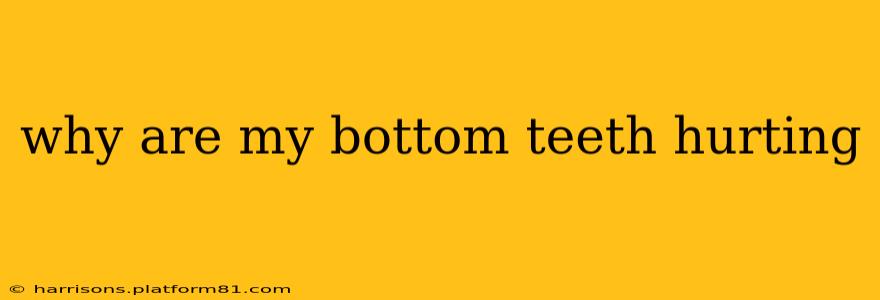Experiencing pain in your bottom teeth can be incredibly disruptive and worrying. The cause can range from minor irritations to serious dental issues. This guide explores the common reasons behind bottom teeth pain, helping you understand the potential problems and when to seek professional dental care.
What Could Be Causing My Bottom Teeth Pain?
Several factors can contribute to pain in your lower teeth. Let's delve into some of the most common culprits:
1. Tooth Decay (Cavities):
This is a leading cause of toothache. Bacteria produce acids that erode tooth enamel, leading to cavities. Lower teeth, due to their position, can be more susceptible to decay if not properly cleaned. Pain can range from a dull ache to sharp, throbbing pain, especially when consuming hot or cold foods or drinks.
2. Gum Disease (Gingivitis and Periodontitis):
Inflammation and infection of the gums can lead to pain in the lower teeth. Gingivitis, the early stage, causes redness, swelling, and bleeding gums. Periodontitis, the advanced stage, involves the destruction of bone and tissues supporting the teeth, resulting in significant pain and potential tooth loss. Neglecting proper oral hygiene is a primary risk factor.
3. Abscesses:
A dental abscess is a pocket of pus formed due to an infection, often at the root of a tooth. This can cause intense, throbbing pain, swelling, and sensitivity to pressure. Abscesses require immediate professional dental care to prevent serious complications.
4. Cracked or Fractured Tooth:
A crack or fracture, even a microscopic one, can cause significant pain, especially when biting down. This is often triggered by trauma, such as biting on a hard object. The pain might be intermittent or constant, depending on the severity of the fracture.
5. Tooth Sensitivity:
This refers to sharp, short-lived pain when consuming hot, cold, sweet, or acidic foods or drinks. It can be caused by enamel erosion, receding gums exposing the dentin (the layer beneath enamel), or bruxism (teeth grinding). Lower teeth are often affected due to their direct contact with food and drinks.
6. Temporomandibular Joint (TMJ) Disorder:
The TMJ connects your jaw to your skull. Disorders of this joint can radiate pain to the lower teeth and jaw area. Symptoms include jaw pain, clicking or popping sounds in the jaw, headaches, and earaches.
7. Wisdom Teeth:
Impacted or partially erupted wisdom teeth can cause pain and discomfort in the surrounding area, often affecting the lower back teeth. Inflammation and infection can exacerbate the pain.
8. Sinusitis:
Inflammation of the sinuses can sometimes cause referred pain to the upper and lower teeth, particularly the upper back teeth and lower front teeth. This is due to the close proximity of the sinuses to the teeth.
When Should I See a Dentist for Bottom Teeth Pain?
Don't ignore bottom teeth pain. Schedule an appointment with your dentist if:
- The pain is severe or persistent.
- You have swelling or inflammation in your gums.
- You experience difficulty chewing or biting.
- You notice a change in the color or appearance of your teeth.
- You have a fever or other signs of infection.
Your dentist can accurately diagnose the cause of your pain and recommend the appropriate treatment, preventing further complications and preserving your oral health. Remember, early intervention is key to resolving dental issues effectively.
